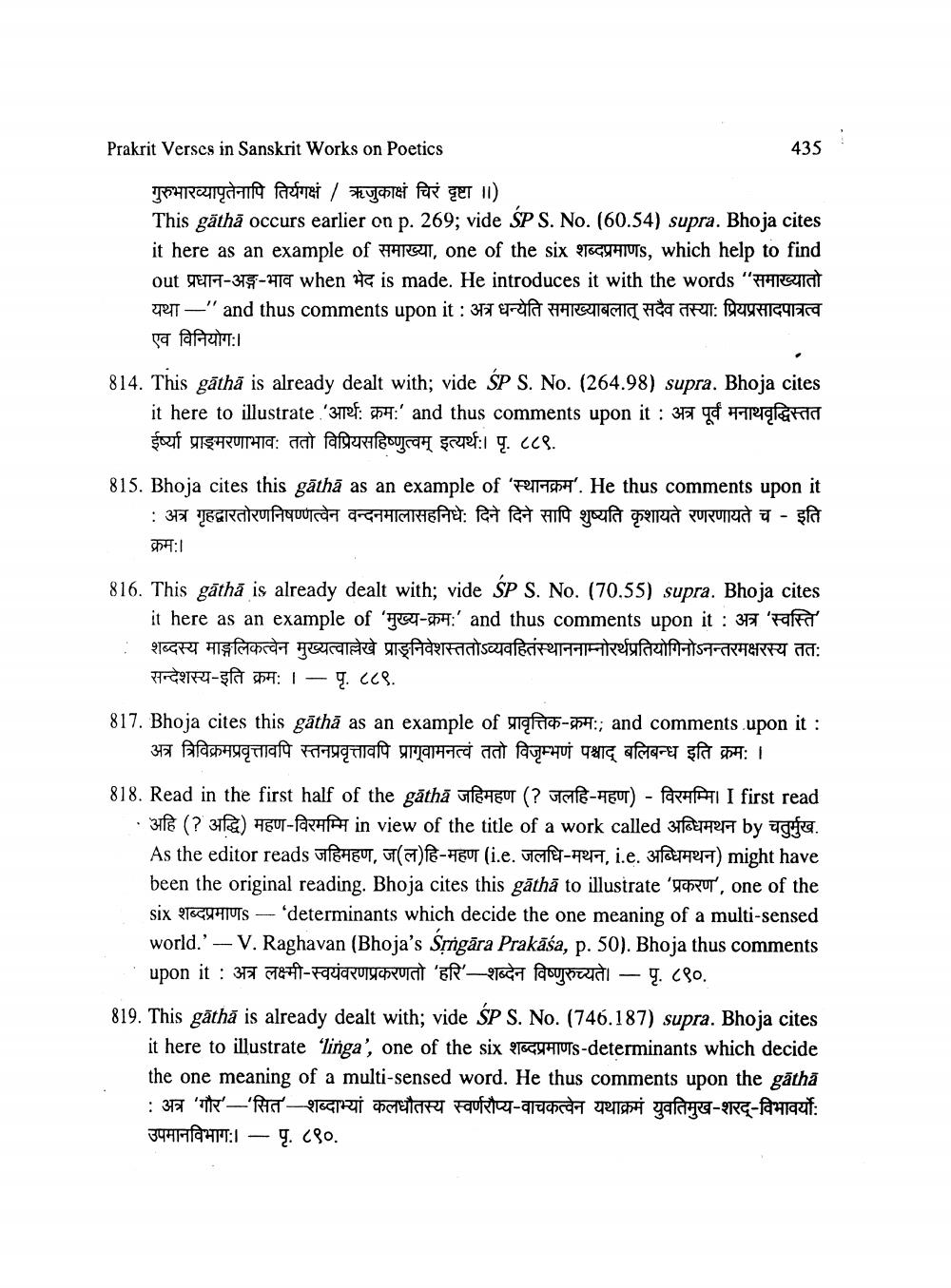________________
Prakrit Verses in Sanskrit Works on Poetics
435
गुरुभारव्यापृतेनापि तिर्यगक्षं / ऋजुकाक्षं चिरं दृष्टा ।।) This gāthā occurs earlier on p. 269; vide SP S. No. (60.54) supra. Bhoja cites it here as an example of समाख्या, one of the six शब्दप्रमाणs, which help to find out प्रधान-अङ्ग-भाव when भेद is made. He introduces it with the words "समाख्यातो यथा-" and thus comments upon it : अत्र धन्येति समाख्याबलात् सदैव तस्याः प्रियप्रसादपात्रत्व एव विनियोग:।
814. This gāthā is already dealt with; vide ŚP S. No. (264.98) supra. Bhoja cites
it here to illustrate 'आर्थ: क्रम:' and thus comments upon it : अत्र पूर्व मनाथवृद्धिस्तत ईर्ष्या प्राइमरणाभावः ततो विप्रियसहिष्णुत्वम् इत्यर्थः। पृ. ८८९.
815. Bhoja cites this gatha as an example of 'स्थानक्रम'. He thus comments upon it
: अत्र गृहद्वारतोरणनिषण्णत्वेन वन्दनमालासहनिधे: दिने दिने सापि शुष्यति कृशायते रणरणायते च - इति क्रम:।
816. This gāthā is already dealt with; vide ŚP S. No. (70.55) supra. Bhoja cites
it here as an example of 'मुख्य-क्रम:' and thus comments upon it : अत्र 'स्वस्ति शब्दस्य माङ्गलिकत्वेन मुख्यत्वाल्लेखे प्रानिवेशस्ततोऽव्यवहितंस्थाननाम्नोरर्थप्रतियोगिनोऽनन्तरमक्षरस्य तत: सन्देशस्य-इति क्रमः | - पृ. ८८९.
817. Bhoja cites this gatha as an example of प्रावृत्तिक-क्रमः; and comments.upon it :
अत्र त्रिविक्रमप्रवृत्तावपि स्तनप्रवृत्तावपि प्रागवामनत्वं ततो विजृम्भणं पश्चाद् बलिबन्ध इति क्रम: ।
818. Read in the first half of the gatha जहिमहण (? जलहि-महण) - विरमम्मि। I first read • अहि (? अद्धि) महण-विरमम्मि in view of the title of a work called अब्धिमथन by चतुर्मुख.
As the editor reads जहिमहण, ज(ल)हि-महण (i.e. जलधि-मथन, i.e. अब्धिमथन) might have been the original reading. Bhoja cites this gāthā to illustrate 'ucheur, one of the six शब्दप्रमाणs - 'determinants which decide the one meaning of a multi-sensed world.' - V. Raghavan (Bhoja's Srigara Prakasa, p. 50). Bhoja thus comments
upon it : अत्र लक्ष्मी-स्वयंवरणप्रकरणतो 'हरि'-शब्देन विष्णुरुच्यते। -पृ. ८९०. 819. This gāthā is already dealt with; vide ŚP S. No. (746.187) supra. Bhoja cites
it here to illustrate 'linga', one of the six शब्दप्रमाणs-determinants which decide the one meaning of a multi-sensed word. He thus comments upon the gāthā : अत्र 'गौर'-'सित शब्दाभ्यां कलधौतस्य स्वर्णरौप्य-वाचकत्वेन यथाक्रमं युवतिमुख-शरद्-विभावों: उपमानविभाग:। - पृ. ८९०.




